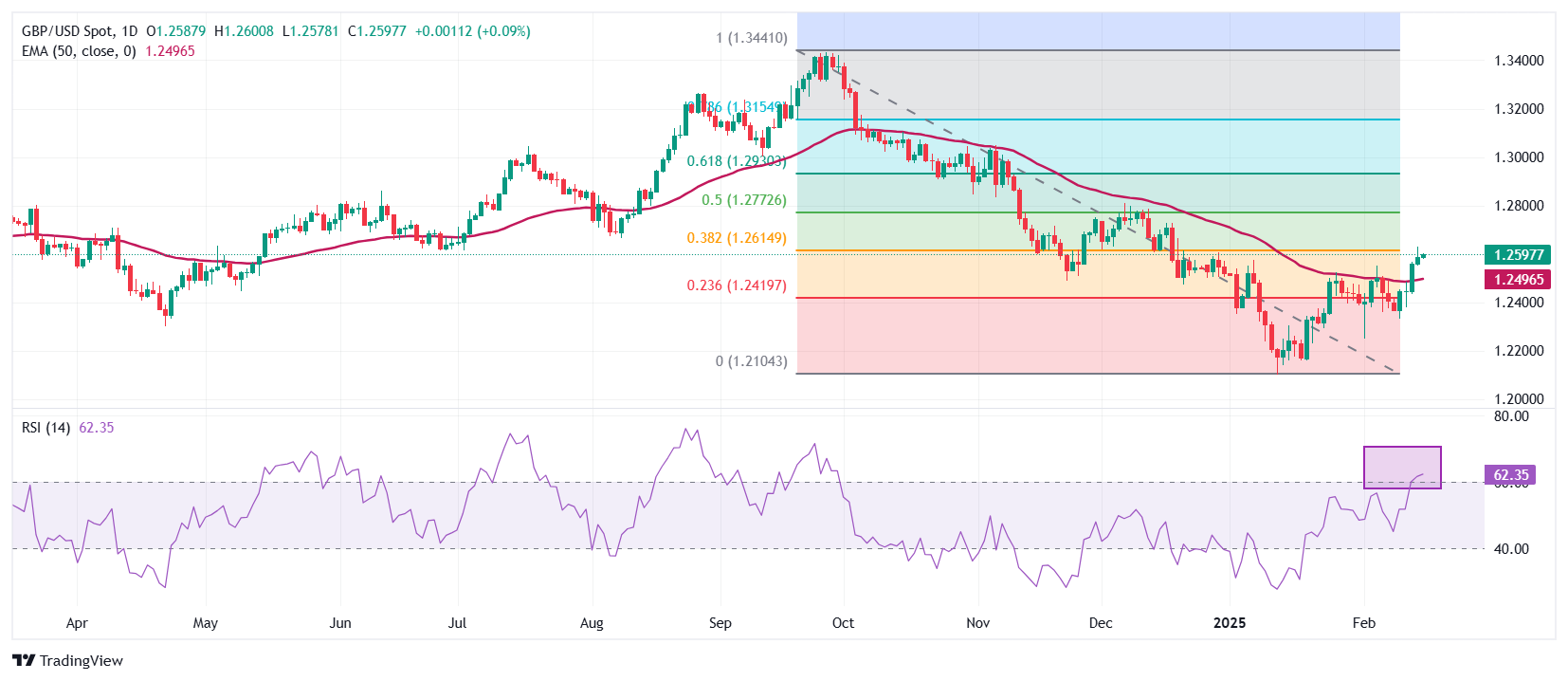- The sterling pound remains stable in front of its main peers on Monday in the midst of uncertainty before the United Kingdom’s employment and inflation data.
- The governor of the BOE, Bailey, could give clues about new signs regarding the perspectives of monetary policy in a speech on Tuesday.
- Logan de la Fed reiterates his opinion of maintaining caution in interest rate cuts.
The sterling pound (GBP) remains stable in front of its main peers at the beginning of the week, since investors are cautious before the United Kingdom’s employment data (UK) for the three months that end in December, which is They will publish on Tuesday.
Investors will pay close attention to the United Kingdom labor market data to know if businessmen are still upset with the announcement of the Foreign Minister of the Exchequer, Rachel Reeves, to increase the contribution of employers to the National Insurance (Ni). In the autumn budget, Reeves increased the social security contributions of employers by 1.2% to 15%, which will enter into force from April.
From the announcement, the hiring rate of the private sector has decreased dramatically, which indicates dissatisfaction among entrepreneurs. In the three months that ended in November, the economy added 35K workers, significantly less than the 173K added in the period from August to October.
The National Statistics Office (ONS) of the United Kingdom is expected to show that the ILO unemployment rate accelerated to 4.5% in December from the previous reading of 4.4%.
Market participants will also focus on the United Kingdom average gains data, which are a key measure of salary growth that has been an important taxpayer to high inflation in the service sector. It is expected that the average gains (including and excluding bonuses) will accelerate at a robust rate of 5.9% compared to the previous 5.6% publication. The measures of strong salary growth would increase the fears that pressures on prices remain stubborn. In the February Monetary Policy Declaration, the Bank of England (BOE) declared that inflationary pressures could accelerate before resuming their path to the objective of 2% due to high energy prices.
Therefore, weak employment conditions and high expectations of inflation due to strong salary growth could stop the risks of stagning.
Together with the employment data, investors expect the speech of the governor of the BOE, Andrew Bailey, who is also scheduled for Tuesday.
Later in the week, investors will also focus on consumer price index (ICC) and retail sales of the United Kingdom for January, which will be published on Wednesday and Friday, respectively.
Daily market summary: the sterling pound remains lateral against the US dollar
- The sterling pound rises to about 1,2600 against the US dollar (USD) in the European session on Monday. The GBP/USD pair remains lateral while the dollar index (DXY) struggles to maintain the immediate support of 106.70, which is a minimum of more than two months.
- The US dollar is still defensive in the midst of an improvement in the feeling of the market. Last week, the feeling of the market became favorable for risk assets due to a delay in the imposition of reciprocal tariffs by the president of the United States (USA), Donald Trump, who will probably not come into force before of April 1. This scenario decreased the fears of an immediate global commercial war, since investors anticipated that President Trump would announce reciprocal tariffs on Thursday.
- Last week, the IPC data and the US Production Price Index (PPI) for January were higher than expected. The president of the Bank of the Federal Reserve of Dallas, Lorie Logan, reiterated on Friday that the Central Bank should keep the caution in interest rates. “I think we are in a good position at this time to observe the data in the coming months and take our time to really look at the data and see how these possible changes will evolve,” Logan said. He also added that the Central Bank is also watching the geopolitics and economic policies of President Donald Trump.
Technical Analysis: The sterling pound oscillates within Friday’s range
The sterling pound trades within Friday’s negotiation range, but aims to break decisively above the 38.2% fibonacci setback around 1,2620. The short -term perspective of the GBP/USD torque has become bullish since it remains above the 50 -day exponential (EMA) mobile average, which is around 1,2500.
The 14 -day relative force index (RSI) advances above 60.00. An upward impulse would be activated if the RSI (14) remains above that level.
Looking down, the minimum of February 3, 1,2250 will act as a key support zone for the torque. Upwards, the fibonacci setback of 50% in 1,2767 will act as a key resistance zone.
LIBRA ESTERLINA FAQS
The sterling pound (GBP) is the oldest currency in the world (886 AD) and the official currency of the United Kingdom. It is the fourth most marketed currency exchange unit (FX) in the world, representing 12% of all transactions, with an average of $ 630 billion a day, according to data from 2022. Its key commercial peers are GBP/ USD, which represents 11%of FX, GBP/JPY (3%) and EUR/GBP (2%). The sterling pound is issued by the Bank of England (BOE).
The most important factor that influences the value of sterling pound is the monetary policy decided by the Bank of England. The Bank of England bases its decisions itself has achieved its main objective of “price stability”: a constant inflation rate of around 2%. Its main tool to achieve this is the adjustment of interest rates. When inflation is too high, the Bank of England will try to control it by raising interest rates, which makes access to credit for people and companies more expensive. This is generally positive for sterling pound, since higher interest rates make the United Kingdom a more attractive place for global investors to invest their money. When inflation falls too much it is a sign that economic growth is slowing down. In this scenario, the Bank of England will consider lowering interest rates to reduce credit, so that companies will borrow more to invest in projects that generate growth.
Published data measure the health of the economy and can affect the value of sterling pound. Indicators such as GDP, manufacturing and services PMI and employment can influence the direction of the sterling pound.
Another important fact that is published and affects the pound sterling is the commercial balance. This indicator measures the difference between what a country earns with its exports and what you spend on imports during a given period. If a country produces highly demanded export products, its currency will benefit exclusively from the additional demand created by foreign buyers seeking to buy those goods. Therefore, a positive net trade balance strengthens a currency and vice versa in the case of a negative balance
Source: Fx Street
I am Joshua Winder, a senior-level journalist and editor at World Stock Market. I specialize in covering news related to the stock market and economic trends. With more than 8 years of experience in this field, I have become an expert in financial reporting.








